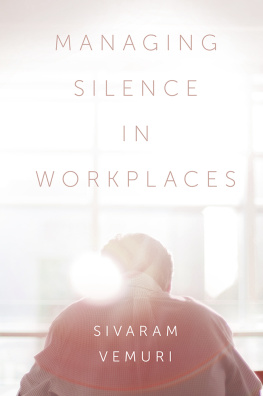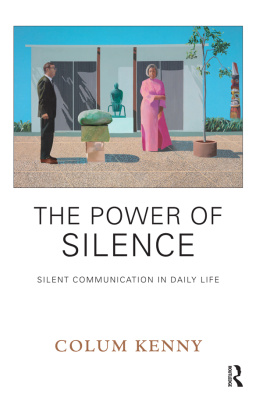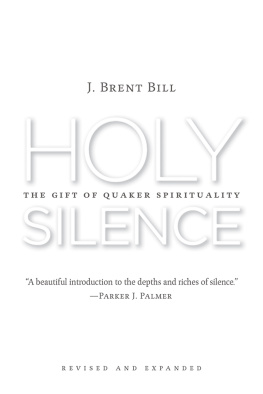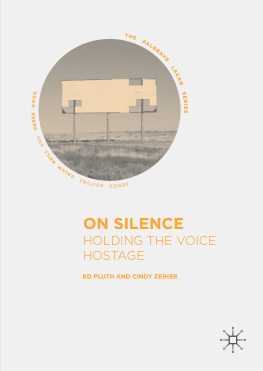No part of this book may be reproduced, stored in a retrieval system, transmitted in any form or by any means electronic, mechanical, photocopying, recording or otherwise without either the prior written permission of the publisher or a licence permitting restricted copying issued in the UK by The Copyright Licensing Agency and in the USA by The Copyright Clearance Center. Any opinions expressed in the chapters are those of the authors. Whilst Emerald makes every effort to ensure the quality and accuracy of its content, Emerald makes no representation implied or otherwise, as to the chapters suitability and application and disclaims any warranties, express or implied, to their use.
Preface
This book is the outcome of several years of introspection and exposure to silences in workplaces that I witnessed myself and learned about from others who shared their experiences with me. I was interested in exploring how managers can deal with silence in the workplace. It is a very common experience but I soon learned that most managers are themselves quite silent about it. Many ignored it and those who did acknowledge it dismissed it as just an employee who had issues to deal with. I was sure there was more to it than this and I wanted to explore how silence in the workplace can be appropriately addressed.
I searched in vain for a methodology that would adequately serve the purpose. I needed a framework that could link individuals workplace decisions to the role managers can play to create environments based on trust and mutual respect, and that contribute to managing change and improving productivity. It was a tall order. It required an investigation into ethical ways to manage silence. It was clear that the solution to managing silence cannot be prescriptive nor descriptive but has to contribute to the managers toolkit. The solution had to lie in understanding the ethics of silence.
I was fortunate to co-author a book with my friend and colleague Nancy Billias on this subject. The book is based on an interdisciplinary (philosophy and economics) framework that we developed; however, as I began researching how to manage silence in the workplace, it became clear that I would need to move from interdisciplinarity to transdisciplinary work. To do justice to the formation of an appropriate management tool, I needed to bring ideas from several disciplines and go beyond to create a comprehensive approach to understanding the management challenges of dealing with silences in workplaces.
explains the several theoretical types of silence that prevail in the workplace. In keeping with the transdisciplinary nature of my exploration, in this chapter I construct the importance of hope to develop the management tool.
is devoted to measuring silence in the workplace and the measure is then applied to real-world constructs of public agencies and private institutions to examine the relevance of the tool for managers who may wish to use it. As I was interested in treating the management of silence in workplaces in an ethical way, I worked with my colleague Silpi Dhungana Pant to illustrate how it can work without being prescriptive on what managers need to do.
In preparing and writing this book, I was helped by many people. I am grateful to all the leaders, managers and employees at my own workplace, Charles Darwin University (CDU), those at the Institute of Managers and Leaders and fellow NT branch members, as well as fellow Rotarians of the Darwin Sunrise Rotary, who have allowed me insights into silences in their decision-making processes. I am also grateful to the line managers in the public and private sector agencies that allowed me to administer a questionnaire to staff and who encouraged staff to cooperate. It had proved exceedingly difficult to gain access to larger organisations and indeed many small ones, so the fact that we received almost 100% response rates, albeit from small agencies, allowed us to draw valid conclusions.
I have benefited immensely from the knowledge I received from all of them. I also wish to acknowledge the contribution of my friends (too many to mention) and family (Jyoti, Alia, Sidharth, Ed, Ila and Ariki) who willingly and sometimes unintentionally shared their own personal experiences with silence. I am grateful for the support I received from the wonderful Roopali Misra and Amander Dimmock who willingly obliged me to bring to life the graphs of my sketches. I am also very much indebted to the wonderful library staff at CDU, Carolyn and Brenda, whose support made my journey into transdisciplinary work so much more rewarding. I finally wish to thank my very dear friend and colleague June Kane for bringing life into the manuscript. Thank you, June, for doing such a wonderful job.
I hope this book will make a small contribution to making workplaces of the present and the future more inclusive of their employees. People are, after all, at the very core of everything we say and do.
Chapter 1
The Silent Killer
Silence is a silent killer of innovation and transformation in organisations, and I was determined to find ways to manage it. It soon became clear that, precisely because this was a silent killer, the focus instead would have to be on risk factors and the perception of risk. Risks are always associated with probabilities, which also imply that not all silence is bad. Not all silence is detrimental to the workplace. Just imagine a workplace where there is zero silence. What a chaos it would be.
Silence does and has to exist, but it must be managed. This means understanding the good, the bad and the ugly aspects of silence. How do we decide how much silence is beneficial for the workplace? What criteria can we use in deciding the extent to which silence might in fact contribute to organisational health? Is employee health the same as organisational health? Once we decide that silence needs to be managed, who will do that and who decides this? Is it the employer or the employee or the environment in which the firm operates? Or is it combination of these? Once decisions are made to manage silence, how do we go about doing that? What is the best way to manage silence? Are there universal laws of managerial behaviour for optimising employee silence in organisations? If so, what are they? If not, why not? These questions are the starting point for this book.
To answer the questions, I had to find a framework that was independent of workplace culture and move away from the idea that employee silence is necessarily a problem. Most current published material considers silence as a problem or simply assigns meaning to silence by describing it. I wanted to get away from the problem-centric notion of silence and go beyond description.














